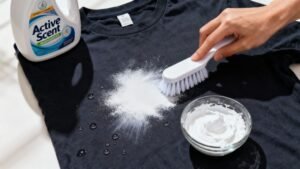
How to Clean Polyester Without Ruining It
Learning how to clean polyester is far simpler than you might think. Honestly, it all comes down to three core principles: use cool or warm water, a gentle detergent, and low heat when you’re drying. Once you master these basics, you’ll sidestep all the common issues like shrinking or heat damage, making sure your favorite pieces last longer and look impeccable.
Why Proper Polyester Care Is A Game Changer
Polyester is a true powerhouse fabric, known and loved for its durability and wrinkle resistance. But even the toughest materials demand the right kind of care to maintain their integrity.
Proper cleaning techniques do more than just lift away dirt; they are essential for preserving the fabric's structure, preventing those annoying little pills, and keeping colors looking as vibrant as the day you bought them.
When you ignore the care label or get aggressive with harsh methods, the results are always disappointing. High heat can cause irreversible shrinking or even melting, while the wrong wash cycle can lead to static cling and odors that just won’t quit. Think of this guide as your complete roadmap to avoiding those pitfalls and turning your laundry routine into a true art form.
The Do's and Don'ts at a Glance
To make things easy, here’s a quick-reference table that boils down the most important rules. This is your cheat sheet for flawless polyester care, every single time.
Quick Guide to Polyester Cleaning Do's and Don'ts
| Action | Why It's Important |
|---|---|
| Do use cool or warm water | Hot water can damage the fibers, cause colors to bleed, and permanently set certain stains. It's a risk not worth taking. |
| Don't use chlorine bleach | It’s far too harsh. Bleach will break down polyester fibers, leading to yellowing and a weakened fabric structure over time. |
| Do turn garments inside out | This simple step is a lifesaver. It protects the outer surface from friction, dramatically reducing pilling and the risk of snags. |
| Don't overload the washer | Overcrowding prevents a thorough clean and increases friction between clothes, causing unnecessary wear and tear. Give your clothes room to move. |
| Do use a low heat setting | High heat is polyester's number one enemy. Tumble dry on low or, even better, let it air-dry to preserve its shape and feel. |
| Don't wring out wet items | Wringing can stretch and distort the fabric’s delicate weave. Instead, just gently squeeze out any excess water. |
Following these simple guidelines will make a world of difference in how your polyester garments look and feel, wash after wash.
Preserving Fabric Integrity
Every single wash cycle impacts your clothing. In fact, research shows that repeated washing can alter the structural properties of polyester. This is why a thoughtful approach matters—it protects both your garments and the environment.
A few small adjustments, like using gradually cooling rinses, can make a significant difference. For items that are blends or require special attention, like a cozy comforter, it's always smart to consult a specific guide. You can find detailed instructions in this Snuggle Comforter Care Guide.
At Active Scent, we believe laundry should be a luxurious ritual, not a chore. Our odor-free laundry detergent delivers a powerful, deep clean without any competing fragrances, creating the perfect neutral base. This prepares your fabrics to fully absorb the bold, mysterious, and unforgettable olfactory statements of our luxury scented fabric softeners. LAUNDRY NEVER SMELLED SO GOOD!
Your Go-To Machine Washing Method for Polyester
Let's be honest—the washing machine is the easiest way to handle polyester, and with a few smart moves, you can keep your favorite pieces looking sharp and vibrant for years. The real magic happens before you even hit the "start" button. A little prep work is all it takes to prevent disasters like color bleeding or fabric damage.
Your first step, always, is to sort your laundry. Separate whites, lights, and darks to stop any colors from running together. But don't stop there. Think about fabric weight, too. Tossing a lightweight polyester blouse in with heavy denim is a recipe for pilling and unnecessary wear on the more delicate piece. And if you're mixing in other synthetics like viscose, remember they have their own rules—you can find our complete guide on how to launder viscose right here.
Choosing the Right Settings and Detergent
With your laundry sorted, it’s time to dial in the machine settings. For polyester, cool or warm water is non-negotiable. Hot water is the enemy; it can cause those synthetic fibers to shrink or weaken over time.
Look for a permanent press cycle on your machine—it’s literally designed for fabrics like this. It uses warm water, a slower spin, and a cool-down period to stop wrinkles from setting in. If you don't have that setting, a gentle or delicate cycle is your next best option.
Now for the detergent. This is where you lay the foundation for a truly luxurious scent experience. You need a powerful, deep-cleaning formula, but it shouldn't have its own overpowering fragrance.
An odor-free laundry detergent acts as the ultimate neutral base. It is carefully formulated for a deep and effective clean without competing fragrances, perfectly preparing your fabrics for a luxurious, scented fabric softener. This powerful cleaning ensures zero interference with the final olfactory statement you want to make.
The Importance of Load Size
You might not think much about how full the washer is, but it makes a huge difference. If you stuff the machine, your clothes won't have room to move, leading to a half-hearted clean and a mess of wrinkles. But a tiny load can be just as bad.
Recent studies have shown that microfiber shedding—those tiny plastic bits that wash out from polyester—can range from 124 to 308 mg per kilogram of fabric. Shockingly, smaller loads can cause up to a fivefold increase in shedding, probably because there’s more friction when fewer items are tumbling around.
For perfect results, aim to fill the drum about three-quarters of the way. This gives your clothes enough space to get thoroughly clean while minimizing wear and tear and reducing your environmental footprint. It’s the sweet spot for keeping your polyester looking flawless.
How to Hand Wash Delicate Polyester Items
While your washing machine can handle most polyester without a second thought, some pieces just need a more personal, gentle touch. We're talking about those sheer blouses, intricate lingerie, or anything with delicate beading or embroidery. For these, hand washing is non-negotiable.
This gentle method protects the fabric's integrity, sidestepping the snags, stretching, and potential damage from a machine's aggressive tumbling. It's a simple, almost meditative process that puts you in complete control, ensuring your most cherished garments stay beautiful for years to come.
Preparing Your Wash Basin
First, grab a clean basin or use your sink. Fill it with lukewarm water—you're aiming for around 30°C (86°F). This temperature is the sweet spot: warm enough to activate the detergent but cool enough to protect the delicate polyester fibers. Hot water is the enemy here; it can weaken the fabric and even cause some blends to lose their shape entirely.
Now, add just a small amount of a high-quality, gentle detergent. This is the perfect moment for a formula that cleans deeply without leaving behind any conflicting scents. A powerful odor-free detergent is ideal, as it creates a perfectly neutral base, prepping the fabric for its final, luxurious conditioning.
With Active Scent, our POWERFUL DETERGENTS FUSED WITH LUXURIOUS FRAGRANCES deliver a spark of joy and a surge of confidence. Our odor-free detergent is the ultimate neutral base, masterfully formulated for a deep clean and designed to perfectly complement our range of luxury scented fabric softeners.
Give the water a quick swirl with your hand to make sure the detergent is fully dissolved before adding your garment.
The Gentle Washing and Rinsing Technique
Submerge your polyester item in the soapy water. Gently press it down until it’s fully saturated, then just let it be. A good 20-30 minute soak gives the detergent time to work its magic, lifting away dirt and oils without any harsh scrubbing.
After the soak, it's time for a little gentle agitation. Swish the garment through the water with soft, sweeping motions. If you're washing a sheer top, focus on gently squeezing the sudsy water through the fabric. For something with a bit more texture, like a blended knit, you can use a slightly more direct (but still gentle) rubbing motion on any specific spots.
Once it's clean, drain the basin and refill it with fresh, cool water to rinse. Submerge the garment again, pressing it gently to work the soap out. You’ll probably need to repeat this a couple of times until the water runs clear and free of suds.
Finally, gently squeeze out the excess water. Whatever you do, never wring or twist the fabric. That’s the quickest way to permanently stretch and damage those delicate fibers, ruining the garment's beautiful shape for good.
A Practical Guide to Removing Stains from Polyester
Polyester is one of the most resilient fabrics out there, but it's not stain-proof. While it does a great job repelling water-based spills, it has a serious weakness for anything oil-based. Think salad dressing, grease, or that stray drop of makeup.
The secret to winning the battle against these stubborn spots? Act fast. Get to it before the garment even thinks about going into the washing machine.
Your immediate instinct should always be to blot, not rub. Seriously, rubbing just grinds the stain deeper into those synthetic fibers, making your job ten times harder. Gently press a clean cloth or paper towel onto the spot to soak up as much as you can. For larger items like cleaning cloth car seats, which are often polyester, this first step is non-negotiable.
And a quick pro tip: always do a spot test on a hidden area, like an inside seam. It's a simple check that ensures your stain remover won't bleach or damage the fabric.
Tackling Different Types of Stains
Not all stains play by the same rules. Different messes need different tactics, but a few household staples can turn you into a stain-removal pro.
- Oil and Grease Stains: These are polyester’s arch-nemesis. Generously cover the spot with baking soda or cornstarch to draw out the oil. Let it sit for 15-30 minutes, then brush it off. A dab of mild dish soap will break down whatever grease is left.
- Ink and Dye Stains: Rubbing alcohol on a cotton ball is your best friend here. Dab gently—you’ll see the ink start to lift almost instantly. The alcohol evaporates quickly, which helps prevent the stain from spreading.
- Sweat and Food Stains: A simple mix of equal parts white vinegar and water works wonders. The acidity in the vinegar is perfect for breaking down the proteins in sweat and food. For really tough smells, we have more tips in our guide on how to remove tough odors from clothes.
For a quick reference, here's a cheat sheet for the most common culprits.
Polyester Stain Removal Cheat Sheet
This table is your go-to guide for treating the most common polyester stains before they set. Keep it handy, and you'll be prepared for anything.
| Stain Type | Recommended Pre-Treatment | Washing Instructions |
|---|---|---|
| Grease or Oil | Cover with cornstarch or baking soda for 30 minutes, brush off, then dab with mild dish soap. | Wash in cool or warm water with a powerful detergent. |
| Ink | Gently blot the stain with a cotton ball soaked in rubbing alcohol until the ink lifts. | Launder as usual, checking to ensure the stain is gone before drying. |
| Coffee or Tea | Blot with a mixture of equal parts white vinegar and water. | Wash in the warmest water the care label allows. |
| Sweat or Blood | Soak in cold water, then apply a paste of baking soda and water to the affected area. | Machine wash in cold water. Avoid heat, as it can set protein-based stains. |
| Makeup | Use a makeup wipe or micellar water to gently lift the stain before treating with dish soap. | Wash on a cool cycle with a deep-cleaning detergent. |
Remember, this pre-treatment step is where the real magic happens.
The pre-treatment phase is where the battle is won. Once you’ve addressed the specific stain, a powerful, deep-cleaning detergent is your secret weapon. It works to lift the pre-treated stain during the main wash, ensuring a flawless, EXCEPTIONAL finish.
The Final Wash for a Flawless Finish
Once you've pre-treated the stain, it's time for the wash. Always use cool or warm water. Hot water is your enemy here—it can permanently set the very stain you just worked so hard to remove.
Choose a detergent built for a truly deep clean. We recommend an odor-free formula because it puts all its energy into cleaning, without adding any conflicting scents. This creates the perfect neutral canvas, getting your fabrics ready to be infused with a luxurious fragrance from a high-quality softener.
This isn't just about getting clothes clean. It's about transforming a routine chore into a sensory experience, leaving a lasting impression long after the laundry is done.
Drying Polyester for a Flawless, Wrinkle-Free Finish
The journey to perfectly clean polyester doesn't stop when the wash cycle ends. How you dry your garments is just as critical. The wrong move here can undo all your careful work, leaving you with wrinkles, static, or even worse—irreversible heat damage.
Polyester is fundamentally a heat-sensitive fabric. Exposing it to high temperatures can cause the synthetic fibers to shrink, warp, or even melt, which permanently messes with the fabric's texture and fit. That’s why air drying or a very low-heat tumble dry is non-negotiable.
The Best Drying Methods for Polyester
You've got two great options for drying polyester, each with its own perks.
- Air Drying: This is by far the gentlest method and the best way to extend the life of your clothes. Just hang your polyester items on a clothesline or a drying rack. A pro tip: keep them out of direct sunlight, as it can fade vibrant colors over time.
- Tumble Drying: If you're pressed for time, a machine dryer is fine—but you absolutely must use the lowest possible heat setting. Think "tumble dry low" or an "air fluff" cycle. The key is to pull the clothing out the second the cycle finishes to stop wrinkles from setting in.
Your drying method is the final touch in the cleaning process. It’s your last chance to protect the fabric's integrity and prepare it for a truly luxurious finish. Proper drying not only prevents damage but also minimizes static cling, creating the perfect canvas for a bold, unforgettable fragrance.
The Final Step: A Luxurious Scent
Once your polyester is clean and nearly dry, it’s time for the masterstroke that elevates your laundry from a chore into a full-blown sensory experience. This is where a luxury fabric softener comes in, doing far more than just taming static.
The right softener, inspired by the spirit of iconic French houses like Dior, Mugler, and Chanel, infuses every single fiber with a bold, hypnotic scent. Imagine a fragrance where deep, earthy patchouli fuses with the burning radiance of amber, while fiery pimento berries ignite the composition with spice. This is how you leave a lasting impression.
Just as precise temperature control is vital for drying polyester, it's also a critical factor in other clothing production processes. Understanding polyester's heat sensitivity in apparel manufacturing shows just how much this detail matters. It’s this attention to the small things that separates standard care from an exceptional ritual. Our guide on how to make laundry smell good dives even deeper into this concept.
The durability of polyester itself is constantly evolving. Recent advancements have even led to self-cleaning fabric coatings that boost tensile strength from 489.4N to 536.4N after treatment. It’s clear that modern care methods can seriously prolong the life of our favorite fabrics.
Common Questions About Cleaning Polyester
Even after you've nailed down the basics, some specific questions always seem to pop up on laundry day. Think of this as your go-to guide for those real-world moments when you need a quick, confident answer. Let's tackle the most common polyester puzzles.
Can You Use Bleach On Polyester
This is a hard no. Reaching for chlorine bleach is one of the worst things you can do to polyester. It's an aggressive chemical that attacks the synthetic fibers, causing permanent yellowing and making them brittle and weak over time. It’s simply not worth the risk.
For stubborn stains or brightening up whites, grab an oxygen-based bleach instead. It gives you the whitening power you need without the damage, making it a much smarter, gentler choice. Still, it's always a good idea to test it on a hidden spot first, like an inside seam, just to be safe.
How Do You Get Wrinkles Out Without An Iron
Polyester is famous for being wrinkle-resistant, but sometimes creases just happen, especially after being packed away. The absolute best way to smooth them out is with a garment steamer. The gentle steam relaxes the fibers without the harsh, direct heat of an iron, which can easily melt the fabric.
Don't have a steamer? The old shower trick is a classic for a reason. Hang the garment in your bathroom during a hot shower, and the steam will work its magic. Another great method is to toss the item in the dryer on a low or no-heat setting for 10-15 minutes with a damp towel. The moisture creates just enough steam to release the wrinkles.
Why Does My Polyester Clothing Still Smell After Washing
This is an incredibly common—and frustrating—problem. Polyester fibers are oleophilic, which is a fancy way of saying they are oil magnets. They trap body oils, and when bacteria feast on those oils, you get a stubborn funk that a standard wash often can’t remove.
Your secret weapon here is a pre-soak. Mix a solution of one part white vinegar to four parts cool water and let the garment soak for at least 30 minutes before it goes into the wash. This breaks down the oils and neutralizes odors. Follow that up with a powerful, high-quality detergent designed to strip away residue, leaving the fabric perfectly prepped to absorb a deep, luxurious fragrance.
Is It Better To Air Dry or Machine Dry Polyester
Honestly, both methods work, but air drying will always be the superior choice. It's the gentlest way to dry polyester, completely removing any risk of heat damage while helping the garment keep its shape and color. It's a simple step that will seriously extend the life of your clothes. This is also the rule for other delicate materials; our guide on how to care for cashmere explores this further.
But we all get busy, and sometimes the machine is a must. If you need to use the dryer, just live by the golden rule for synthetics: low heat. Always choose the lowest temperature setting or an "air-dry" cycle to protect the fibers.
The goal isn't just to clean your clothes; it's to transform a chore into a ritual. Mastering these details ensures your polyester is not only pristine but also becomes the perfect canvas for a bold, hypnotic, and unforgettable fragrance—a true olfactory statement.
Elevate laundry from a mundane task to a moment of pure luxury. With Active Scent, your clothes get a powerful clean that prepares them for an unforgettable sensory journey.










